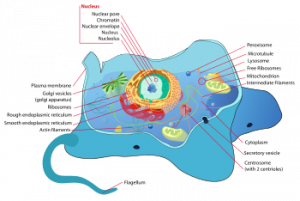Types of Eukaryotic Cells
Characteristics of Eukaryotes
Eukaryotic cells are extremely diverse in structure and function. In all eukaryotes, the cytoplasm contains a variety of small, membrane-enclosed functional units called ‘organelles’. Although there are many different types of eukaryotic cells found in nature, the most familiar to us are those found in animals and plants.
Organelles
What are organelles? For an analogy, let’s consider a manufacturing plant with several specialized departments. Each department has a specific function which contributes to the overall production process. Each department also has employees who work together within the department to coordinate their efforts. By organizing the workforce into specialized departments, the manufacturing plant operates in a more efficient manner.
Similar to the manufacturing plant example, in eukaryotic cells, specific processes are carried out most efficiently by specialized “departments” to speed the production and availability of compounds such as the energy-rich molecule ATP or macromolecules such as proteins. The specialized departments of the cell are various membrane-enclosed compartments which isolate and concentrate the molecules necessary for different “manufacturing” processes.
These tiny compartments are called organelles, a name that is especially appropriate since they act as “little organs” of the cell. Just as heart, lungs, and other organs have unique functions in the human body, each organelle has specific duties within the cell.
Continue to review the function of the major organelles found in eukaryotic cells in the subsequent modules.
Plant Cells
Plant cells are distinct from animal cells in that they contain:
- Cell Walls – strong, structural elements comprised of the polysaccharide cellulose. Provide structure and protection for the plant cell
- Central Vacuole – a membrane-enclosed organelle which stores water, nutrients and waste substances. The central vacuole regulates the water pressure inside of the cell (turgor pressure). When dehydrated (think wilted lettuce), this pressure is reduced and the plant cells lose overall shape and rigidity.
- Chloroplast – membrane-enclosed organelles which perform the complex chemical process called photosynthesis, which involves the capture and transformation of sunlight energy into energy-storing molecules such as glucose. This ability is referred to as ‘autotrophism’.
Animal Cells
Animal cells are distinct from plant cells in that they lack cell walls and chloroplast. Because they cannot make their own food, animal cells are considered to be ‘heterotrophic’. In addition, animal cells do not use large central vacuoles for maintaining pressure inside the cell. Most of the other organelles found in eukaryotes are found in both plant and animal cells.

We will explore these specialized organelles next…
Plant Cells vs. Animal Cells
In the video below, the key differences between plant and animal cells are highlighted:
Summary
Plant and animal cells share many characteristics such as:
- Presence of a nucleus that stores DNA/Genetic Information
- Surrounded by protective plasma membrane
- Presence of membrane-bound units called organelles
In addition, plant cells are distinct from animal cells in that they contain:
- Cell Walls – strong, structural elements comprised of the polysaccharide cellulose. Provide structure and protection for the plant cell
- Central Vacuole – a membrane-enclosed organelle which stores water, nutrients and waste substances. The central vacuole regulates the water pressure inside of the cell (turgor pressure). When dehydrated (think wilted lettuce), this pressure is reduced and the plant cells lose overall shape and rigidity.
- Chloroplast – membrane-enclosed organelles which perform the complex chemical process called photosynthesis, which involves the capture and transformation of sunlight energy into energy-storing molecules such as glucose. This ability is referred to as ‘autotrophism’.